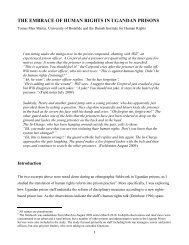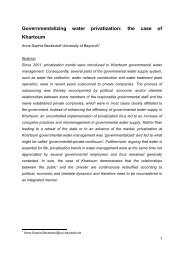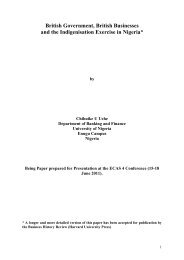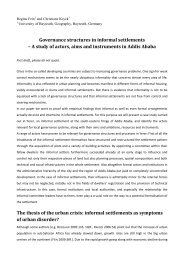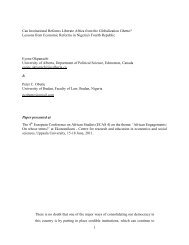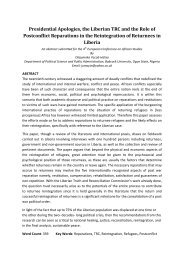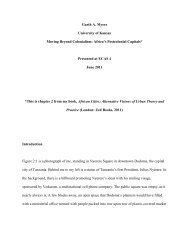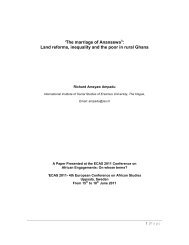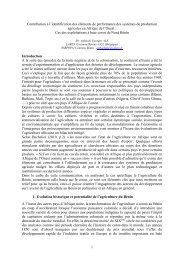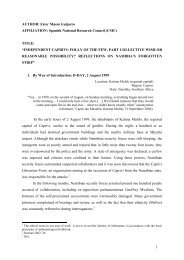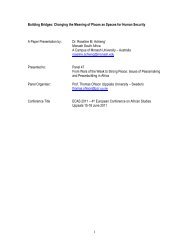Germain Ngoie Tshibambe - Full paper - The Nordic Africa Institute
Germain Ngoie Tshibambe - Full paper - The Nordic Africa Institute
Germain Ngoie Tshibambe - Full paper - The Nordic Africa Institute
You also want an ePaper? Increase the reach of your titles
YUMPU automatically turns print PDFs into web optimized ePapers that Google loves.
0<br />
Karachika !<br />
Nigerian Movies and Nigerian Migrants in the “Glocal City”. <strong>The</strong> Case of Lubumbashi<br />
Paper to be presented to the Panel on<br />
‘Migration and <strong>Africa</strong>n Cities: International Dimensions’<br />
<strong>The</strong> 4 th European Conference on <strong>Africa</strong>n Studies<br />
15-18 June 2011<br />
Uppsala, Sweden<br />
By Prof. <strong>Germain</strong> <strong>Ngoie</strong> <strong>Tshibambe</strong><br />
Department of International Relations<br />
Faculty of Social, Political and Administrative Science<br />
University of Lubumbashi/Katanga<br />
Democratic Republic of Congo
Introduction<br />
1<br />
Lubumbashi has a long tradition in being a cosmopolitan city. This tradition originates<br />
from the colonial era when the city was built up as there was the presence of numerous<br />
minerals that needed manpower in order to be exploited. At its inception, Lubumbashi was<br />
fed by migratory influxes. While speaking about the cosmopolitan city, it is worth recalling<br />
the deep meaning we attach to the adjective cosmopolitan. This term deriving from<br />
cosmopolitanism that is the Greek conjunction of „world‟ (cosmos) and „city‟ (polis) “is about<br />
reaching out across cultural differences through dialogue, aesthetic enjoyment, and respect; of<br />
living together with difference. It is also about the cosmopolitan right to abide any hospitality<br />
in strange lands and, alongside that, the urgent need to devise ways of living together in peace<br />
in the international community” (Werbner, 2008: 2).<br />
With the same dynamics as an urban space, Lubumbashi becomes more and more a<br />
“glocal city”. By this way, we want to account for the continuity Lubumbashi is displaying on<br />
the level of migration influxes and also its connectivity to the global economy. With the term<br />
„glocal city‟, we want to introduce some insights so as to complete what Saskia Sassen<br />
attributes to the „global city‟. According to Sassen (2001: xviii-xxii), the „global city‟ as a<br />
reality comes from the intricate forces of the economic globalization and the global control<br />
that produce a new urban spatiality “which pivots both on cross-border networks and on<br />
territorial locations with massive concentrations of resources.” <strong>The</strong> complexity of an urban<br />
space that is a global city stems from economic practices induced by globalization. This is<br />
true, but it seems that Sassen‟s standpoint on the global city neglects to help grasping how in<br />
the periphery, spaces are linked to this global system and the ways these connected spaces are<br />
shaping surreptitiously and impacting their neighboring spaces which are close to them but<br />
also very far from the core of the global connectedness. <strong>The</strong> circulation of information and the<br />
effects of the global culture unfold their impact on these peripheral urban spaces. <strong>The</strong>refore<br />
with the notion of the „glocal city‟, we want to put emphasis on these postcolonial urban<br />
spaces featured by the rampant crisis within which life and all the contradictions of modernity<br />
are lived directly and indirectly in the context of hopes, dreams and grievances.<br />
As a glocal city, Lubumbashi continues to attract peoples from everywhere. <strong>The</strong><br />
demographic landscape of Lubumbashi is shaped by the mixing of nationals and of migrants<br />
as well. Among the new comer migrants, we can cite the case of Nigerians who become more<br />
and more visible. While their visibility is growing step by step, Nigerians‟ signature is already<br />
written in the representation of surrounding local communities thanks to „‟Karachika‟‟ series<br />
movies which are the offspring of Nollywood. Does Nollywood get an impact on the<br />
Congolese population living in Lubumbashi? Answering such a question will open up<br />
windows of understanding the new ways of grasping in the era of globalization the cultural<br />
influences shaping imaginaries of people and the emergence of imagined communities that<br />
are constitutive of the transnational frames. And according to our approach, “the transnational<br />
is not just about immigrants. It is the space increasingly inhabited by us all” (Brydon, 2004:<br />
1). As such, viewing transnational implies going beyond the binary vision opposing “them”<br />
and “us”; instead we are to consider both “them” and “us” at the same time. Nigerian video<br />
movies become more and more constitutive parts of the imaginaries of Lubumbashi
2<br />
population caught up by the postcolonial crisis. <strong>The</strong> convergence of the aesthetics of Nigerian<br />
movies and the hopes and frustrations of Lubumbashi inhabitants is part of the intricate<br />
process of creating a shared imagined community induced by “the minor transnational<br />
practice” (Adejunmobi, 2007). <strong>The</strong> popularity of Nigerian video films comes to create a new<br />
space competing with the current influence spread by the “cultural imperialism” (Shah and<br />
Tajima, 2008: 25) and on the local television screens the monopole era when Western and US<br />
movies were the sole sources of entertainment alone is over. Everyday popular culture in<br />
Lubumbashi is kept active by Nollywood more than by Hollywood.<br />
This <strong>paper</strong> aims at investigating the impact of Nollywood movies on the dialogue<br />
between Lubumbashi people and Nigerian migrants insofar as these films become<br />
predominant as popular video films attracting and shaping the imaginaries of Lubumbashi<br />
population. By grasping this impact, we want to be led by the first hypothesis according to<br />
which we consider the influence and the popularity of the Nigerian movies as a strategic mode<br />
of interactions paving the way for an indirect dialogue between imagined Nigerians, concrete<br />
Nigerians and Lubumbashi population. Beyond this imagined dialogue, we will analyze<br />
Nigerian migrants‟ agency as they come to impose their visibility in this city. Nigerian<br />
migrants do not sell only Nollywood video films, they get specific economic niche which<br />
helps them to create homes and livelihoods within Lubumbashi. In considering their main<br />
economic activities, we will try to understand the resources they use in order to maintain their<br />
business in creating contacts here and there and last we will look at the core aspect of the<br />
strategy Nigerian migrants perform so as to realize their integration in Lubumbashi. <strong>The</strong><br />
second hypothesis is that the predominance of the informal economic activities in<br />
Lubumbashi creates a specific context through which Nigerian business agency unfolds. <strong>The</strong><br />
data for this <strong>paper</strong> have been collected during a three year research conducted in Lubumbashi<br />
(2008-2010). Live stories and interviews with Nigerian migrants and Congolese as well are<br />
the main methods used in gathering information on this research. Our approach is essentially<br />
qualitative even though we used a snow-ball sampling for gathering some data. In the first<br />
section, we will define some core concepts; in the second section, we will analyze the<br />
Nigerian migrants‟ profile, their agency and integration strategy; the third section presents a<br />
constructivist approach of understanding local perception of Nigerians as they are living here.<br />
1. Defining concepts: minor transnationalism and integration<br />
<strong>The</strong> theoretical framework of this <strong>paper</strong> turns around two broad themes which get<br />
passionate controversies. <strong>The</strong> first theme refers to globalization and culture whereas the<br />
second theme relates to migration. Discussions on globalization and culture tend to focus on<br />
varying perspectives of understanding the cultural imperialism the central aspect of which is<br />
the “notion of a predominantly Western-dominated one-way flow of information” (Shah and<br />
Tajima, 2008: 23). Schiller (1976) described cultural imperialism as “the sum of the process<br />
by which a society is brought into the modern world system and how its dominating stratum is<br />
attracted, pressured, forced and sometimes bribed into shaping social institutions to<br />
correspond to, or even promote, the values and structures of the dominating center of the<br />
system” (1976: 9). Schiller (1976: 21) goes on to assert that cultural institutions of the West,<br />
including the mass media, are part of a world capitalist system and serve as the “ideologically
3<br />
supportive informational infrastructure of the modern world system‟s core – the multinational<br />
corporations.” <strong>The</strong> intricate task of the cultural institutions is about to create and deliver<br />
consumers to the multinational corporations. It is worth recalling that the purpose of globally<br />
distributed cultural products from the West aims at “creating packaged audiences whose<br />
loyalties are tied to brand-named products and whose understanding of social reality is<br />
mediated through a sale of commodity satisfaction” (Schiller, 1976: 23). <strong>The</strong> relationship so<br />
described herein is an imperialistic one in so far as the powerful states impose their cultural<br />
power upon weaker states with little or no reciprocation.<br />
Insofar as the circulation of information is concerned, cultural imperialism puts stress<br />
on the one-way flow of information circulation that lets flow the Western-dominated ways of<br />
thinking and viewing things. Debates aroused and conflicting perspectives came to emphasize<br />
a kind of binary articulation of the various forms of the „global culture‟ within which it needs<br />
to speak about „dominant culture‟ versus local „resistance‟ (Larkin, 1997: 408). To summarize<br />
these debates, suffice to recall Frederic Jameson who distinguished what he called the more<br />
and the less optimistic interpretations of globalization offered by scholarly observers. “Some<br />
theorists celebrated a new eclecticism and „hybridity‟ in cultural production around the world<br />
as different societies interacted with each other and borrowed from each other. Yet other<br />
theorists decried a growing standardization of cultural production as dominant centers flooded<br />
the world with their products and shut out less powerful voices” (Adejunmobi, 2007: 2).<br />
Anyway, the in-between standpoint came to acknowledge the tension between the „‟utopic<br />
and dystopic‟‟ evaluations of the impact of globalization on cultural production (Lionnet and<br />
Shih cited by Adejunmobi, 2007: 2). <strong>The</strong> term “minor transnationalism” as it is used tries to<br />
take into account the “awareness and recognition of the creative interventions that networks of<br />
minoritized cultures produce within and across national boundaries” (Lionnet and Shih, cited<br />
by Adejunmobi, 2007: 2) and accounts for transnational cultural practice stemming from<br />
populations currently marginalized in the global economy. This transnational cultural practice<br />
is a sum of autonomous voices from globally minoritized populations as they emerge on the<br />
new sphere called “the mediascapes” according to Appadurai‟s neologism (cited by<br />
Adejunmobi, 2007: 3).<br />
<strong>The</strong> popularity of Nigerian video films in Lubumbashi highlights the circulation of<br />
media within and between non-Western countries, an aspect of transnational cultural flows<br />
that has been largely ignored in recent theories of globalization. “Karachika”, a video film<br />
made in Nigeria, is so popular on the screen in Lubumbashi that many local channels of<br />
television such as Mwangaza, Nyota, Wantashi, Radio & Télévision Groupe Avenir (RTG@),<br />
Voix du Berger (VBer) and RTLC have planned to diffuse them three times on average per<br />
week. Karachika series offer local inhabitants of Lubumbashi a way of imaginatively<br />
engaging with forms of thinking current life from the same religious background induced by<br />
discourse of the struggle against Satanic forces and the triumph of believing in God that is the<br />
main argument of the revival and Pentecostal churches as the strategic pathway for “a golden<br />
road to success” (Banégas and Warnier, 2001: 13; Tonda, 2000: 48-65; Marshall-Fratani,<br />
2001: 24-44). <strong>The</strong> pertinence of their message creates such a convergence with the local<br />
imaginations constitutive of the “<strong>Africa</strong>n modernity” (Tonda, 2000: 50) that Nigerian video
4<br />
films vie currently with the US films like Dallas, Chrono 24 hours or Falcon Crest which<br />
were popular in the 1990s in Lubumbashi and, in the case of Chrono 24 hours, are still on<br />
screen.<br />
<strong>The</strong> concept integration is also central to this <strong>paper</strong>. With regard to migration,<br />
integration becomes an issue having political and economic dimensions. While leaving his/her<br />
home country, a migrant experiences many migratory spaces and alongside his/her trajectory,<br />
in case s/he is in „final‟ destination country, s/he should perform agency so as to create a new<br />
home, abroad. Creating a new home abroad depends on the juridical framework but also on<br />
his/her agency as it concerns his/her capacity to imagine activities to perform. Before going<br />
ahead, let us say that in referring to Michel Foucault‟s language play, integration is a “word”<br />
and also a “thing”. As a word, integration has numerous meanings depending on the domains.<br />
As a thing, integration is understood either as a process or as an outcome. As used in<br />
migration issues, integration is the process of inclusion of immigrants in the institutions and<br />
relationships of the host society. In Lockwood‟s terms (1964), there is a binary distinction<br />
between “system integration” and “social integration”. System integration is the result of<br />
anonymous functioning of institutions, organizations and mechanisms –the state, the legal<br />
system, markets, corporate actors or finance –as they tend to regulate interactions within a<br />
society. Social integration refers to the inclusion of individuals in a system, the creation of<br />
relationships among individuals and their attitudes towards the society. It is the result<br />
stemming from the conscious and motivated interactions and co-operation of individuals and<br />
groups.<br />
According to western formalism, the integration of migrants is based on the legal<br />
aspects. <strong>The</strong>re is a set of rules and devices as they are designed by the state aiming at<br />
foreseeing the progressive insertion of the migrant. Bosswick and Heckmann (2006: 1)put it<br />
clearly: “<strong>The</strong> question of integrating immigrants into a country is framed primarily at the level<br />
of the nation state. Such an approach makes sense in terms of formulating policies, creating<br />
legal and administrative frameworks and for collecting and disseminating statistical data. »<br />
<strong>The</strong>se rules that are a kind of barriers consist of measures able to frame the access to the labor<br />
market and the citizenship, the latter being a door opening up to political participation of the<br />
citizen. In the context of industrialized countries immigrants live on the intricate process of<br />
exclusion/integration framed by discriminatory measures that are not only racial, but also<br />
legal and social leading to a complex continuum alongside which the legal advantages are set<br />
off by sociological constraints of exclusion. “Unequal employment opportunities in spite of<br />
equal level of training and skills” (Tiberj, 2009: p.219) is the terse reality described for<br />
explaining the process of integration of immigrants in France.<br />
In summary, the “integration of immigrants into a host society should be understood as<br />
a special case of social integration, to which the concepts of placement, acculturation,<br />
interaction and identification can be applied. Other literature has suggested that these be<br />
conceptualized as structural integration, cultural integration, interactive integration and<br />
identification integration” (Bosswick and Heckmann, 2006: 3). Anyway, integration applied<br />
to migration is very complex. According to Tiberj (2009), integration is defined differently<br />
according to economists, sociologists or Law experts. In considering the “French model of
5<br />
integration”, Tiberj (2009: 216-222) distinguishes between two dimensions of integration; the<br />
first and classical dimension concerns the social insertion and economic participation while<br />
the second dimension considered new relates to normative integration. In the case of the<br />
Democratic Republic of Congo (DRC), suffice to notice the lack of migration law. In this<br />
“<strong>paper</strong>less state” (Obotela, 2002), the gap in urban governance and the inexistence of the proactive<br />
policy of “bio-politics” (Foucault, 2001) induce a particular context where it is uneasy<br />
to decipher manifestation of integration from the bottom up. <strong>The</strong> Congolese state does not<br />
have an effective policy for managing migration. <strong>The</strong>refore immigrant integration is<br />
undertaken on the ground at the bottom; this ground can be the street. As we put it, “the<br />
problematic of immigrant integration in DRC can be understood according to certain tracks<br />
such as social mixing, i.e. this way of living which leads immigrants to be in touch for<br />
continuous interactions with the host society inhabitants. <strong>The</strong> social mixing can be analyzed at<br />
the level of housing space occupation. Other tracks are for instance matrimonial exchanges<br />
and the knowledge of local languages” (<strong>Ngoie</strong> and al., 2010: 71)<br />
2. Nigerian migrants in Lubumbashi<br />
It is important to notice that the presence of Nigerian migrants in the human landscape<br />
of Lubumbashi is of recent date. In the DRC, by the 1990s they become predominant as they<br />
occupy economic niches as selling video film CD-Roms and vehicles spares. For instance in<br />
Kinshasa a commercial compound has but Nigerian shops and ware-stores for selling vehicles<br />
spares. This commercial area is called “Nigerian quarter”. In Lubumbashi, Nigerian migrants<br />
came to be visible in the early 2000s. According to Mr. A, 45 year old, a Nigerian migrant<br />
who is here since 2000,<br />
“It is interesting to recognize that the first wave of Nigerians came to Lubumbashi<br />
after 2000. <strong>The</strong>y came from Kinshasa. <strong>The</strong>y were interested in exploring the<br />
business opportunities in the province of Katanga after having done business in<br />
Kinshasa the capital. As was the case in Kinshasa, the business niche for<br />
Nigerians was the selling of video films CD-Roms and the spares.” (material<br />
recorded in Lubumbashi, June 2009)<br />
<strong>The</strong> growing numeric importance of Nigerians does not only appear by the physical<br />
presence of the human subjects referring to as Nigerians, but also it is manifest thanks to the<br />
influence of what we call “Karachika” referring to Nigerian video films the aesthetic content<br />
of which is part of the imaginaries of the Lubumbashi inhabitants. In using the binary feature<br />
of the immaterial presence and the physical presence of Nigerian subjects, we want to grasp<br />
the two dimensions of migration as it concerns Nigerians.<br />
<strong>The</strong> immaterial presence<br />
<strong>The</strong> Nigerian video film is so common to Lubumbashi people that it is not easy to find<br />
out when it becomes part of local mediascape. If Nigerian migrants are told to have been in<br />
Lubumbashi in the 2000s, Nigerian video film has been imported and used as an<br />
entertainment on the local television programmes in the 1990s. <strong>The</strong> 1990s refers to the years<br />
of the chaotic tentative of democratization when President Mobutu was ruling over Congo.<br />
<strong>The</strong> term chaotic tentative of democratization is used so as to put stress on the political
6<br />
impasses faced by the country and that have had social and economic consequences on the<br />
country. <strong>The</strong>se consequences led to an unending and rampant crisis. In this context, religious<br />
imagination became so predominant among the population in order to face the crisis.<br />
Religious imagination accounted for the proliferation of Pentecostal churches. <strong>The</strong><br />
proliferation of Pentecostal churches and the commitment of local population to such<br />
churches are part of the popular strategy aiming at facing the crisis challenge. <strong>The</strong> social<br />
configuration of these practices is constitutive of what Mbembe calls the “state of religion” in<br />
<strong>Africa</strong> (Mbembe, 2000: 16-17). <strong>The</strong> discursive statements heard from theses churches try to<br />
explain “the times of sorrow” in putting stress on the negative influence of Satan and the<br />
“world of darkness”. Birgit Meyer (Meyer, 1995: 237) is right while speaking about “a<br />
popular Christian culture” on which she says: “One of its most striking features is the image<br />
of the Devil and the imagination of evil, in which witchcraft, money and family problems are<br />
recurrent features.” <strong>The</strong>se discursive statements are a constitutive part of the <strong>Africa</strong>n way of<br />
understanding modernity; they are part of “the fields within which people produce meanings<br />
enabling them to analyze critically and thereby shape their life conditions” (Meyer, 1995:<br />
237).<br />
It is at this level of common and popular imaginaries in Lubumbashi that there exists a<br />
convergence that helps the Nigerian video films to be so popular here as elsewhere in <strong>Africa</strong>.<br />
<strong>The</strong> popularity of these films is so popular that they are used as they are with the English<br />
language. Translation in local languages is done with broad comments as the film proceeds in<br />
the original language, i.e. English. <strong>The</strong> Nigerian video films display a social role of keeping<br />
alive all the complex sets of imaginaries. Charles Taylor (cited by Brydon, 2004: 3) suggests<br />
that “the social imaginary is not a set of ideas; rather it is what enables, through making sense<br />
of, the practices of a society.” An imaginary is a meaning-making process through which<br />
ordinary people understand their social surroundings. It may be carried in images, stories, and<br />
legends and will usually be shared by large groups of people. Video films are one among<br />
other tools for conveying such imaginaries. And the fact that television is so broadly used in<br />
many families in the city accounts for the evidence according to which it becomes the<br />
medium through which video films as images feed social imaginaries so shared by<br />
Lubumbashi inhabitants.<br />
Several local channels of television have programmes through which Nigerian video<br />
films are shown. In a week, more than three times there are programmes displaying these<br />
video films. <strong>The</strong> most popular local televisions are as many as is the case of Mwangaza,<br />
Nyota, Wantashi, Radio & Télévision Groupe Avenir (RTG@), Voix du Berger (VBer). <strong>The</strong><br />
audience for such video films are as various as “young or middle-aged women and young<br />
men”, those categories considered by Birgit Meyer (1995: 237) as very committed like<br />
“members of Pentecostal prayer groups and churches.” According to an informant, Mrs. Betty<br />
(30 years old),<br />
“In our family, we are very fond of “karachika” series movies. We are nine in our<br />
family. Except my father, the persons who are interested in viewing such films are<br />
my mother, my four sisters, my two young brothers and I. We know the television
7<br />
channels and different programmes as they are planned on each channel. We do<br />
not want to miss any session of the video film.”<br />
It is not worth recalling all the Nigerian films shown in Lubumbashi. What is<br />
important to notice is the fact that by the term “karachika”, we understand all Nigerian<br />
movies. But this general term is misleading because there is a change in the aesthetical<br />
content of these movies. While analyzing Nigerian movies, there are two types of drama<br />
which tend to distinguish them. <strong>The</strong> first type of movies is a thriller: it is full of violence<br />
scenes that lead to horror and reference to powers of darkness. <strong>The</strong> second type of drama is<br />
soft as it does not get extreme violence plot. It deals with issues of marriage, love and<br />
business within which the struggle between the strength of God word and the attraction of<br />
Satan and the devils world unfolds the final victory of God. As an informant tells us,<br />
“According to me, it is useful to consider “karachika” as representing the thriller<br />
plot drama as shown in the Nigerian films. For instance, do you know that in our<br />
city, a prostitute woman who uses magic potion for her job is called “karachika”?<br />
This kind of films becomes more and more rare nowadays. People do not like<br />
them anymore. <strong>The</strong> second type of Nigerian films consists of drama having plots<br />
whose rationale is the struggle between the Christian faith and devil and darkness<br />
worlds. It is the second film that is popular nowadays.” (M. Bobo, 47 years old,<br />
interview in Lubumbashi, January 2010).<br />
<strong>The</strong> growing importance of Nigerian films in Lubumbashi creates a context within<br />
which they constitute the materialization of a kind of cultural migration, preceding the arrival<br />
of Nigerian migrants as human subjects. <strong>The</strong> growing importance of these films led to pave<br />
the way to the constitution of a common imagined community. In the era of globalization and<br />
as in relation to the deep structure of representing the sorrows that are daily over-present,<br />
Lubumbashi inhabitants realize through these films that here as there people have the same<br />
view of representing the “<strong>Africa</strong>n modernity”. Here represents Lubumbashi whereas there is<br />
constituted of people like the Nigerian actors who perform plots sharing the same complex set<br />
of the “popular Christian culture” (Meyer, 1995: 237) and another way of reading the<br />
modernity from Nigeria‟s setting (McCall, 2002). Nigerian video film is in Lubumbashi like<br />
the flag and its signature wrote down the way announcing the “invasion” of Nigerian migrants<br />
and Nigerian ways of doing businesses.<br />
Nigerians’ material presence in Lubumbashi and the shaping of the city<br />
Statistical data on the exact count of Nigerian migrants living in Lubumbashi are not<br />
available. This difficulty notwithstanding, the empirical observation in some commercial<br />
areas of Lubumbashi gives the measure of the presence of Nigerian migrants. Stores<br />
belonging to Nigerians flourish. <strong>The</strong>refore we want to present the profile of Nigerian migrants<br />
living in Lubumbashi as we can draw it from our survey. <strong>The</strong> Nigerian diaspora has more men<br />
than women. In our sample, Nigerian migrants who are married with their spouses in<br />
Lubumbashi represent 54,6%; bachelors represent 45,4%. <strong>The</strong> configuration of the married<br />
couples is complex for there are Nigerians who get their spouses coming from homeland but<br />
there are also Nigerians married to Congolese women. Indeed, this category has a feeble ratio
8<br />
in the sample interviewed. With regard to their religious identity, Nigerians living in<br />
Lubumbashi are Muslims (53%) whereas the remaining percentage is shared between<br />
Pentecostals (30 %), Catholics (10 %) and without faith (7%). <strong>The</strong>re are no Nigerian children;<br />
therefore the average age varies between 30 and 58. <strong>The</strong> school background unravels that<br />
more than 50% of Nigerian migrants do not state their level of school completion; those who<br />
have completed university are very few (2%); many of them have completed secondary<br />
school (47%). <strong>The</strong> school background helps understand the driving force behind the decision<br />
to migrate for these migrants that has generally been overwhelmingly economic, not political.<br />
Such a standpoint has been raised by Dirk Kohnert (2010: 17) while analyzing motivations of<br />
Chinese migrants‟ decision to migrate to West <strong>Africa</strong>.<br />
<strong>The</strong> ethnic origin of the Nigerian migrants in the city of Lubumbashi has the<br />
predominance of Yoruba even though Igbo and Haoussa are also there. While speaking about<br />
the ethnic group origin, Nigerian migrants were very cautious not willing to explore this issue.<br />
An informant gave us this narrative:<br />
“I am an Igbo. I was doing business in Lagos in importing goods from Benin. It<br />
was very difficult to face the crisis there in my country. My friend told me there<br />
was opportunity of doing business in Congo-Kinshasa. I let you know this friend<br />
is a Yoruba. As I know by experience, a country being in the post-conflict period<br />
has several opportunities for business. I agreed with my friend for coming here in<br />
Congo. First of all, I was in Kinshasa before reaching Lubumbashi. Here we are<br />
all and all Nigerians.”(John, 45 years old, interview in Lubumbashi, June 2009).<br />
It is worth noting that Nigerian migrants living in Lubumbashi come from urban<br />
milieus in Nigeria. Many cite Lagos where they come from and they belong to the lower<br />
middle class. <strong>The</strong>y got a migration experience while being in their country where they<br />
migrated internally from one town to another in doing business for survival. And migration in<br />
D.R. Congo is their first international migration experience. Nevertheless as they are here,<br />
they are used to travelling to the countryside for business reasons. From Lubumbashi, they go<br />
to Kasumbalesa, Likasi, Fungurume and Kolwezi. Lubumbashi is the administrative capital of<br />
the mining province of Katanga. <strong>The</strong> four cities are as important as is Lubumbashi and many<br />
activities linked to the mining sector boom attract people there. <strong>The</strong> duration of stay among<br />
Nigerian migrants varies between one day and ten years. According to a Nigerian informant,<br />
the first wave of Nigerian migrants came to Lubumbashi in early 2000s. After having done<br />
business in this milieu they realize the benefit of “having one foot on the ground” and in<br />
discovering the richness for business opportunities, the success story of one leads to calling<br />
another one. <strong>The</strong> dynamics of migration among Nigerians stems from the success story of the<br />
first comers. <strong>The</strong>refore the cycle of migration wave is still at the beginning but its dynamics is<br />
going on. After exploring and “conquering” Kinshasa, Nigerian migrants have come to be<br />
present in Lubumbashi.<br />
It is important to note that, insofar as <strong>Africa</strong>n migration to Lubumbashi is concerned,<br />
this town is undertaking a transition period through which while the migrants from the West<br />
<strong>Africa</strong> are predominant, it is worth recalling the two trends that shape this migration<br />
dynamics. <strong>The</strong> first trend gave predominance to Malians and Senegalese in the migration to
9<br />
Lubumbashi as was the case in Congo in general. In the 1970s, “Muhusa”, “Ndingari” and<br />
“Westaf” are local denominations for identifying all the migrants of <strong>Africa</strong>n origin, mainly<br />
from West <strong>Africa</strong> who were coming to Congo. <strong>The</strong>re were Guineans, Malians, Senegalese<br />
and Ghanaians (Biaya, 1998: 342). <strong>The</strong> migration trajectory of this first trend of West <strong>Africa</strong>n<br />
migrants in Congo marked by the flow and the flow-back is explained by Biaya (1998: 342)<br />
as follows:<br />
“<strong>The</strong> word (Ndingari) is used to designate West <strong>Africa</strong>ns that came to Zaire<br />
(DRCongo) around the end of the nineteenth century. <strong>The</strong>y were called coastmen<br />
by the colonials and participated in the building of the Belgian colony in many<br />
respects, either as troops, postmen and couriers, or as independent traders. <strong>The</strong>y<br />
eventually made Zaire their second home as they had lived there in solace for over<br />
eighty years. As propagators of Islam and Maraboutism, they succeeded in<br />
entrenching Mamy Wata which is a fine example of inter-cultural<br />
complementarity. However unfortunately in 1964, Tshombe, then Prime Minister,<br />
was imprisoned in Cairo by Nasser for the murder of Lumumba. Released several<br />
hours later, he returned home to expel Guineans, Malians and Ghanaians. From<br />
that time on, the practice changed into a diplomatic weapon. In 1967 and 1971,<br />
Mobutu, his family and the ruling class used it to create a clientelism in the illicit<br />
traffic in diamonds and works of art by removing West <strong>Africa</strong>ns from the mining<br />
towns to other towns.”<br />
From the 1980s onward, West <strong>Africa</strong>n migrants out-migrated from Congo. It is<br />
why the arrival of Nigerians in the 1990s in Kinshasa and in the 2000s in Lubumbashi is<br />
considered the feature of the second trend of migration from West <strong>Africa</strong>. Whereas the<br />
first West <strong>Africa</strong>n migrants did business in diamonds and gold and the maraboutism –<br />
Sylvie Bredeloup used the term “diamond-migration” 1 to account for the rationale of<br />
the migration of Senegalese and Malians to Central <strong>Africa</strong>– the current trend of<br />
migration dominated by Nigerians gave them the visibility in specific economic niches<br />
we will speak about later.<br />
During our research, a question was asked to some Nigerians in order to explore their<br />
prospect for the future. More than 80% of the respondents said they are undergoing an<br />
interesting experience here in Congo and that they do not plan to leave Lubumbashi for<br />
another place. Obika, a Nigerian migrant, 48 years old, who has been in Lubumbashi since<br />
2005, puts it clearly:<br />
“This is my second country of migration. After I left Nigeria, I went to Liberia to<br />
do business. <strong>The</strong> situation was not so interesting. Do you know that I went to<br />
Liberia on my own initiative? It was very hard for me. I came here thanks to a<br />
kinsman. In the beginning, I had to adapt to the new environment. <strong>The</strong> language<br />
issue was the first challenge. I try to speak Swahili. It is not hot as is the case in<br />
Lagos, which is also an aspect I like to be here. I know some remote areas in the<br />
Katanga province. What I do now helps me to earn enough to live on. I am<br />
already married to a Congolese woman. I plan to let my younger brother come<br />
1 This term was used during discussions at the workshop organized 16-19 th November 2010 in Dakar by the<br />
International Migration <strong>Institute</strong> in partnership with the University Cheik Anta Diop II. <strong>The</strong> theme of the<br />
workshop was “the <strong>Africa</strong>n Contribution to Migration theory”. See www.imi.qeh.ox.ac
10<br />
here for business as I do. As it is still interesting to do business here, I do not<br />
foresee any move to another place outside Congo.” (Interview in Lubumbashi,<br />
November 2010).<br />
<strong>The</strong> last, but not least feature we want to draw on the profile of Nigerian migrants<br />
concerns their business activities. At this level, the first typology leads us to forge a twofold<br />
kind of activities. <strong>The</strong> first category includes economic activities; the second category<br />
concerns religious activities. Due to the context of Lubumbashi where informal activities are<br />
predominant, economic activities consist of visible and invisible business. <strong>The</strong> criterion for<br />
understanding such a distinction relates to the kind of business the migrant subject is doing. If<br />
a Nigerian migrant gets a store/shop –small or medium- or a very small corner where he sells<br />
goods, we are likely to speak about a visible economic activity. According to information<br />
obtained from the economic business public services at the municipality office, shops and<br />
stores belonging to Nigerians are growing in number in Lubumbashi. More than twenty stores<br />
were registered as owned by Nigerian migrants in 2010. <strong>The</strong> invisible business consists of<br />
activities that are difficult to trace back. For instance, when a subject is doing business as a<br />
broker in buying and selling minerals such as gold or diamonds and this activity leads him to<br />
move constantly from one town to another, such an activity is categorized as an invisible<br />
business. While considering the economic activities Nigerian migrants are doing, as diverse<br />
and several as they are, we can cite selling of spares, business in informatics and internet<br />
access to the public, the selling of Nigerian video films and music and retail trade of used<br />
shoes and dresses. <strong>The</strong> invisible activity is linked to the trafficking of mineral resources and<br />
other natural resources in the DRC. In our research, we got in touch with a Nigerian migrant<br />
who is in Lubumbashi for a long time and whose activity consists of seeking for some rare<br />
stones, for instance the “tiger-eye” stone. He wanders all the remote areas and the countryside<br />
in search of such a stone.<br />
<strong>The</strong> religious site is occupied as well by Nigerian migrants. We find Pentecostal<br />
churches whose founders are Nigerians. <strong>The</strong> Model Prayer assembly, for instance, is the<br />
denomination of a church belonging to a “globalized” Nigerian pastor. <strong>The</strong> liturgical service<br />
in this church even when the head pastor is absent is held in English. According to narratives<br />
of his fellows,<br />
“Our pastor lives here for a short time. Normally, when he is here, it is for no<br />
more than two weeks. He has two churches, one in Nigeria and another in<br />
Namibia. His family is in Namibia. It is in the latter country that he spends much<br />
of his time. <strong>The</strong>re are deputy pastors who manage the church administration in his<br />
absence. About the fellows or the members of this church, we find Nigerians and<br />
Congolese.” (Interview with Job, 30 years old, a Congolese member of the<br />
church, November 2010 in Lubumbashi).
11<br />
Figure 1: Types of business<br />
Formal sector Informal sector<br />
(1) Spares sale<br />
(2) CD-ROMs (films and music)<br />
(3) Miscellaneous<br />
(4) Religious agency<br />
3. <strong>The</strong> Nigerian migrants’ integration strategy<br />
We should start this entry by recalling that the integration of migrants in the DRC is to<br />
be understood in the specific context of this country within which the main feature is the<br />
predominance of the informal sector over the formal one. Such an economic structure has an<br />
impact on the behavior of migrants insofar as integration is concerned. As the labor market is<br />
almost inexistent and is not attractive, migrants do not come here in order to look for jobs<br />
opportunities. <strong>The</strong>y come to the DRC to do business on their own, using the resources of the<br />
formal sector and the informal sector. Figure 1 helps understand the overlapping nature of<br />
businesses as they are done by Nigerian migrants. Indeed many Nigerians interviewed seem<br />
to have several activities among which we find the official/visible and unofficial/invisible<br />
activities. Moreover, Nigerian migrants coming here do it as an individual initiative thanks to<br />
their social networks that provide them with information. Mr. Okushi, a Nigerian migrant of<br />
40 years old who has been in Lubumbashi since 2006 said:<br />
“When I left Lagos to come here, I knew that Congo was a country of several<br />
business opportunities. I came here to do business and make money. I did not<br />
come here to seek for a job and work for another person. While on my way to<br />
Lubumbashi, my dream was to find quickly opportunities and very interesting<br />
opportunities of business. That was my dream. I am still keeping this dream while<br />
being here. <strong>The</strong>refore, speaking of the professional integration of migrants in this<br />
city is unrealistic.”<br />
Nigerian migrants in Lubumbashi are usually in groups and they often meet. While<br />
working in a cybercafé belonging to a Nigerian, I observe that some of the customers coming<br />
to the place were Nigerians. This kind of behavior is observed among other migrants living in<br />
the city. For instance, in the area where there are Malians and Senegalese, shops and places<br />
belonging to Malians become a site for visits and meetings among these people. <strong>The</strong>y try to<br />
create a homeland atmosphere in being together at some time of the day: generally it is after<br />
the working hours that they meet sharing beer and discussing issues of their home country. In<br />
order to facilitate their integration, Nigerians use some ways of “doing things”. <strong>The</strong> first way<br />
consists of getting Congolese “gatekeepers”. It is important to note that the category of local<br />
“gatekeepers” is a complex notion referring to intricate networks through which we find a<br />
variety of social relations from simple persons who are likely to do any kind of jobs at the<br />
service of the Nigerian migrants to “big men”, be they political, military or administrative<br />
officials. <strong>The</strong> latter kind of top officials is called the “umbrella”. <strong>The</strong> advantage of getting a
12<br />
“top umbrella” is to use it in case of necessity for overcoming any kind of trouble the migrant<br />
faces in daily life. If the migrant is a businessman, s/he should have social relations with top<br />
officials who can intervene to resolve a problem his migrant “customer” has at any public<br />
service. This kind of intervention consists of helping the migrant not be “troubled” or<br />
controlled by the public services.<br />
<strong>The</strong> second way is about the matrimonial strategy. This strategy consists of Nigerian<br />
migrant marrying a Congolese woman so as to get a foot on the local soil. In our sample,<br />
marriage between Nigerians and Congolese women has a feeble percentage (15%). Here is the<br />
statement given by a Nigerian migrant about the marriage strategy:<br />
“You ask a question on my marriage with a Congolese woman. This question is<br />
difficult to account for. I go married because I love my wife. But it is important to<br />
recall that marrying a Congolese woman is a kind of contract I enter into with this<br />
country in which I want to reside for a long time. Do you know the Latin byword<br />
according to which “where I am well, there is my homeland country.” I am a<br />
businessman. I am used to travelling to remote areas of Katanga to sell and buy<br />
goods. My wife helps me and as I speak Swahili, my contacts are facilitated.”<br />
But the general trend is that many bachelors after a while are likely to look for Congolese<br />
mattresses. Of course, this is not a strategy of integration as it unravels psychological aspects<br />
of life of human beings.<br />
<strong>The</strong> third way of assessing the path for integration relates to the social mixing through<br />
which Nigerian migrants live by renting houses so close to Congolese‟s houses. <strong>The</strong>re is no<br />
social barrier between Nigerian migrants and Congolese people. <strong>The</strong> “contact zones” (Yeoh<br />
and Willis, 2005) are so many that Nigerian migrants share some common aspects with local<br />
populations. It is why Nigerian migrants live so close to local populations in terms of housing<br />
location choices. Many Nigerian migrants are still living in the rented houses (more than 80 %<br />
of Nigerian migrants interviewed) whereas Nigerian migrants who have success in business<br />
have big houses they purchased themselves (3%). Compared to Malians and Senegalese who<br />
thanks to the long stay going back to the 1960s have occupied some areas for housing, in<br />
Lubumbashi Nigerian migrants do not yet have their own and specific areas where they<br />
reside. In contrast to Chinese migrants who have come late in the same span of time,<br />
Nigerians work lonely without being surrounded by brothers of the homeland country. <strong>The</strong><br />
“ethnic business” is still more prevalent among Chinese migrants than among Nigerian<br />
migrants. Individualism is prevalent among Nigerian migrants in terms of business activities<br />
whereas solidarity feelings are strong among Chinese.<br />
Without exaggerating it is worth recalling the fact that Nigerians in business seem to<br />
have less trust in one another. Swindle and breach of trust are common aspects of behavior<br />
among Nigerian in Lubumbashi. Black sheet in business is counted among the Nigerian<br />
migrants themselves. John is a Nigerian migrant of 40 years old. He has been in Lubumbashi<br />
since 1997. Nowadays he is facing a bankruptcy in business. Here is his story:<br />
“I got in touch with a compatriot who is residing in South <strong>Africa</strong>. He told me he<br />
came to Lubumbashi to sell goods he imported from South <strong>Africa</strong>. He was in need
13<br />
of about US $ 2,000 to pay customs charges. I lent him US $1,000 I had borrowed<br />
from my relatives. This compatriot took back his goods from the customs services<br />
and up to now, he disappeared. As the business is not going well for me that is a<br />
catastrophe.”<br />
Nigerian migrants seem to have the same kind of ingeniosity in business as Chinese for they<br />
come to have monopole in some economic niches as the sale of vehicle spares and video<br />
films. Slowly, they try to invade the commercial centre of Lubumbashi.<br />
We want to explore the local population perception of Nigerian migrants. <strong>The</strong> dialogue<br />
between local population and Nigerian migrants is both the one of the shared and imagined<br />
community and the intricate feeling of “usness” versus “otherness”. <strong>The</strong> shared and imagined<br />
community stems from the effects spread by the “cultural migration” induced from<br />
Nollywood films. <strong>The</strong> popularity of Nigerian films is so that Nigeria is viewed as a big nation<br />
having a big creativity. <strong>The</strong> impression of Nigeria as a big nation is given through the setting<br />
of dramas: the material environment of the plot takes place in the very nice buildings and<br />
houses with attractive vehicles showing the richness of the country. As an <strong>Africa</strong>n country,<br />
Nigeria as it is filmed unfolds the imagination of the possible positive progress all the <strong>Africa</strong>n<br />
people expect to reach. This image has a psychological force of expressing the dreamt<br />
aspiration of people struck by the daily crisis. An informant tells us such a view while saying:<br />
“I am a 2 nd year at the university. For my leisure I am a fan of Nigerian films. <strong>The</strong><br />
setting of some films discloses the greatness of Nigeria. <strong>The</strong>re are many beautiful<br />
houses; actors use new and attractive cars. In my mind I think Nigeria is on the<br />
way of being an emergent nation.” (Nola, 22 years old, interview in Lubumbashi,<br />
March 2011).<br />
But beyond this impressive image, Congolese people have another perception of the<br />
Nigerian migrant. This perception relates to business Nigerians are doing in the DRC.<br />
Nigerians are perceived as doing business in selling fake goods in the domain of spares. This<br />
perception seems to be generally used for characterizing many migrant diasporas doing<br />
business in Lubumbashi. <strong>The</strong> term “Guangzhou product” becomes a common term used to<br />
describe pejoratively the goods/merchandises sold by Chinese. Goods (spares for vehicles)<br />
sold by Nigerians in Lubumbashi are viewed as of the second category and are termed also by<br />
the China reference. “<strong>The</strong>y come here in order to look for money. <strong>The</strong>ir spares goods are of<br />
bad quality. <strong>The</strong>y are like other migrants who invade our city”, such is the statement<br />
expressing attitude towards Nigerians.<br />
4. Conclusion<br />
Lubumbashi as a mining and business city continues to attract peoples from<br />
everywhere. <strong>The</strong> demographic landscape discloses a dynamic shift of people. <strong>The</strong> arrival of<br />
Nigerians in Lubumbashi is close to the influence of the Nigerian video films among the local<br />
population. <strong>The</strong> influence of these films is evident as it infuses the imaginaries of the struggle<br />
against Satan and evil forces that are perceived as the root causes of the sorrows striking<br />
individuals and the society as well. <strong>The</strong> convergence of the aesthetics of the Nigerian movies<br />
and the hopes and frustrations of Lubumbashi inhabitants is part of the intricate process of
14<br />
creating a shared imagined community induced by “the minor transnational practice”<br />
(Adejunmobi, 2007).<br />
Two observations are worth citing. First, the influence and the popularity of Nigerian<br />
movies are a strategic tool of interactions having paved the way for an indirect dialogue<br />
between imagined Nigerians, concrete Nigerians and Lubumbashi population. While living in<br />
Lubumbashi, Nigerian migrants do not sell only Nollywood video films, they get a specific<br />
economic niche which helps them to create homes and livelihoods within Lubumbashi.<br />
Networks are functioning among Nigerians so as to let the circulation of information help<br />
each one. Second, the predominance of the informal economic activities in Lubumbashi<br />
creates a specific context through which Nigerian business agency unfolds. As such,<br />
Nigerians have activities that are both formal and informal. <strong>The</strong> capacity of bargaining things<br />
at the threshold of the formal and the informal is the creative tool used by Nigerian migrants<br />
to achieve success while living in Lubumbashi.
Bibliography<br />
15<br />
Adejunmobi, Moradewun A., 2007, Nigerian Video Film as Minor Transnational Practice, in<br />
Postcolonial Text, vol.3, n° 2.<br />
Adesokan, Akin, 2009, “Practising „Democracy‟ in Nigerian Films”, in <strong>Africa</strong>n Affairs, n°<br />
108/433, pp. 599-619.<br />
Banégas, Richard and Warnier, Jean-Pierre, 2001, “Figures de la réussite et imaginaires<br />
politiques”, in Politique <strong>Africa</strong>ine, n° 82, Juin, pp. 5-21.<br />
Bosswick, Wolfgang and Heckmann, Friedrich, 2006, Integration of migrants: Contribution of<br />
local and regional authorities, Report to European Foundation for the Improvement of Living<br />
and Working Conditions & Cities for Local Integration Policy Network, available online at:<br />
http://www.eurofound.eu.int, accessed on April 6 th , 2010.<br />
Brydon, Diana, 2004, Transnational literacies, global English, and mobile imaginaries,<br />
http://myuminfo.umanitoba.ca/Documents/3860 accessed on 30th April 2011.<br />
Daniel, Dominique, 2009, “Bilan de l‟intégration des immigrants aux Etats-Unis”, in Jaffrelot,<br />
Christophe and Lequesne, Christian (eds.), L’enjeu mondial. Les migrations, Paris, Presses de<br />
la Fondation nationale des sciences politiques, pp. 195-205.<br />
Kareithi, Peter and Nixon Kariithi, 2008, “Black Hawk Down and the Framing of Somalia:<br />
Pop Culture as News and News as Pop Fiction”, in <strong>Africa</strong> Media Review, volume 16, n° 1,<br />
pp.1-20.<br />
Kohnert, D., 2010, Are the Chinese in <strong>Africa</strong> More Innovative than the <strong>Africa</strong>ns? Comparing<br />
Chinese and Nigerian Entrepreneurial Migrants‟ Cultures of Innovation, Working Papers,<br />
n°140, German <strong>Institute</strong> of Global and Area Studies, available online at http://www.gigahamburg.de/working<strong>paper</strong>s,<br />
accessed on October 14 th , 2010.<br />
Larkin, Brian, 1997, Indian Films and Nigerian Lovers: Media and the Creation of Parallel<br />
Modernities, Journal of the International <strong>Africa</strong>n <strong>Institute</strong>, vol. 67, n° 3, pp. 406-440.<br />
Accessible online at htpp://www.jstor.org/stable.1161182, accessed on 28 June 2008<br />
Lyons, Terence and Peter Mandaville, 2010, “Think Locally, Act Globally: Toward a<br />
Transnational Comparative Politics”, in International Political Sociology, vol. 4, n° 2, June,<br />
pp.124-141.<br />
McCall, John Christensen, 2002, “Madness, Money, and Movies: Watching a Nigerian<br />
Popular Video with the Guidance of a Native Doctor”, in <strong>Africa</strong> Today, vol. 49, n° 3, Fall, pp.<br />
79-94 (Article).<br />
Marshall-Fratani, Ruth., 2001, “Prospérité miraculeuse: les pasteurs pentecôtistes et l‟argent<br />
de Dieu au Nigeria”, in Politique <strong>Africa</strong>ine, n° 82, Juin, pp. 24-44.<br />
Mbembe, A., 2000, “A propos des écritures africaines de soi”, in Bulletin de Codesria, n°1,<br />
pp. 4-19.
16<br />
Meyer, Birgit, 1995, “„Delivered from the powers of darkness‟ Confessions of Satanic Riches<br />
in Christian Ghana”, in <strong>Africa</strong>, vol. 65, n°2, pp.236-255.<br />
Meyer, Birgit, 2001, “Prières, fusils et meurtre rituel. Le cinéma populaire et ses nouvelles<br />
figures du pouvoir et du succès au Ghana”, in Politique <strong>Africa</strong>ine, n° 81, Juin, pp. 45-62.<br />
Obotela, R.N., 2002, République Démocratique du Congo. Un Etat sans papiers dans le<br />
village Planétaire, Kinshasa : Editions du Centre d‟Etudes Politiques.<br />
Sassen, Saskia, 2001, <strong>The</strong> Global City. New York, London, Tokyo, Princeton and Oxford,<br />
Princeton University Press.<br />
Shah, Hermant and Atsushi Tajima, 2008, “Media Imperialism Reconsidered –Again: Local,<br />
Western, and Indian Media Use in Uganda”, in <strong>Africa</strong> Media Review, volume 16, n° 1, pp.21-<br />
43.<br />
Tiberj, Vincent, 2009, “Le creuset français est-il brisé ? Vraies questions, faux diagnostics”,<br />
in Jaffrelot, Christophe and Lequesne, Christian (eds.), L’enjeu mondial. Les migrations,<br />
Paris, Presses de la Fondation nationale des sciences politiques, pp.215-223.<br />
Tonda, Joseph, 2000, “Capital sorcier et travail de Dieu”, in Politique <strong>Africa</strong>ine, n°79,<br />
Octobre, pp. 48-65.<br />
Werbner, Pnina, 2008, “Introduction: Towards a New Cosmopolitan Anthropology”, in<br />
Werbner, P. (ed.), Anthropology and the New Cosmopolitanism: Rooted, Feminist and<br />
Vernacular Perspectives, ASA Monograph 45, Berg.<br />
Yeoh, B.S.A and Willis, K., 2005, “Singaporean and British transmigrants in China and the<br />
Cultural Politics of „contact zones‟”, in Journal of Ethnic and Migration Studies, vol. 31, n°2,<br />
March, pp. 269-285.




